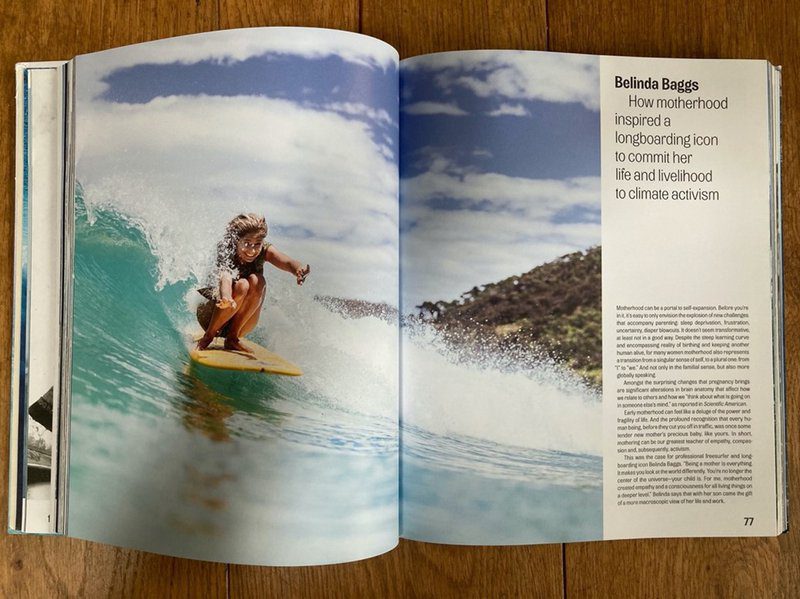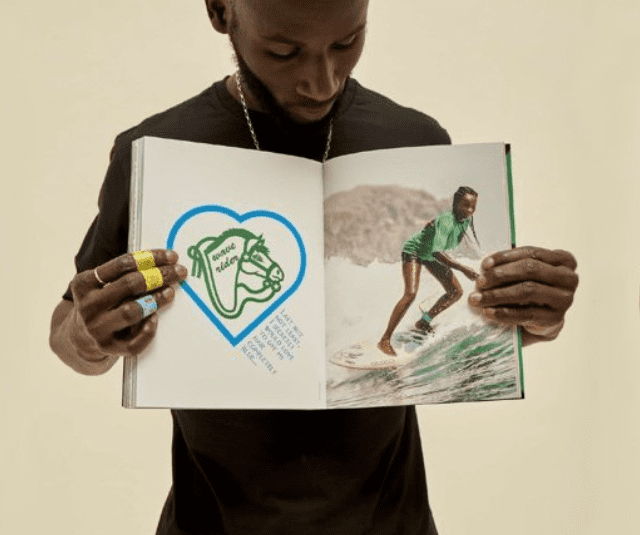Two books that will will blow your mind
Afro Surf and She Surf: The Rise of Female Surfing are two brilliant books to get you fired up about the bright and exciting future of waveriding. Published by South African surf brand Mami Wata, Afro Surf is a beautifully decorated 300-page celebration of African surf culture across this vast and kaleidoscopic continent. Published by Gestalten, She Surf is an equally majestic book written and curated by Lauren Hill, offering a rainbow spectrum of water-women. Both of these books showcase communities often ignored in the surf media, delivering a blast of fresh air to counter surfing’s often white male dominance.
With case studies across the convoluted coastlines of Morocco, Senegal, Cape Verde, Sierra Leone, Liberia, Cote D’Ivoire, Ghana, Nigeria, Congo, South Africa, Mozambique, Somalia and beyond, Afro Surf poses the question to an eclectic mix of waveriders, “What does it mean to be an African surfer today?” Meanwhile, She Surf features a diverse set of twenty five surfers from India’s Ishita Malaviya to Indonesia’s Flora Christin Butarbutar to China’s Monica Guo to showcase what it means to be a water-woman today. “Right now, women are reclaiming our natural place in the global sport, art, and culture of surfing,” writes Lauren Hill.
The introduction to Afro Surf is written by African American academic Kevin Dawson, discussing the long and often over-looked history of aquatic culture in West Africa. Here coastal communities have been experts in the wave rich surf zone on canoes and bellyboards for thousands of years. “Surfing was a means of opening up economic opportunities,” writes Dawson. “It allowed Africans to critically understand surf-zones so they could uniquely traverse them in surf-canoes, linking coastal communities to offshore fisheries and coastal shipping lanes.” And, “surfing was the intergenerational transmission of wisdom that transformed surf-zones into social and cultural places, where the youth holistically experienced the ocean.”
In the 1640s a German working for the Dutch West India Company called Michael Hemmersam wrote the first account of African waveriding in what is now Ghana (over 100 years before Europeans first witnessed and documented Hawaiians riding waves). Today in Ghana there is a thriving modern surf culture, and Michael ‘Ballack’ Bentum is one of the best. In his interview, Ballack celebrates the work that Brett ‘Mr Brights’ Davies has done to raise the profile of West African surfing in the last ten years, raising funds for equipment and hosting surf contests. Davies’ business partner is Ghanaian Sidiq Banda, who explains his passion for surfing as being “like a first-love thing. It’s like light-blue walls, and you’re flying. That’s when you get hooked, when you just need to keep going back because you’re constantly dreaming about waves.”
In a brilliant chapter critiquing Bruce Brown’s 1966 film The Endless Summer, Kunyalala Ndlovu notes that while Brown lamented the ‘discovery’ of “surf that had never been ridden before” Ghanaian Ga kids are playing in the waves on wooden boards as they have done for thousands of years. So “when one pauses the moment the two outsiders walk down toward the water, you can see in the background, in soft focus, little boys playing on what appear to be flat pieces of wood in the water. They were in fact surfing: they just didn’t have a name for it yet.” It is very likely that riding prone on short, wooden, curved-nose boards, is 3,000 to 4,000 years old, and developed independently along the coastlines of Africa and around the Pacific and Indian Oceans.
One of the many refreshing things about Afro Surf is the way it bridges all levels of surfers, from beginners to professionals. For example, in Somalia surfing is used as therapy in conflict-scarred Mogadishu. While South African Cass Collier shares his story of becoming the first non-Hawaiian surfer of colour to hold a world title (for big wave surfing in 1999). He talks about learning to surf at the then whites-only beaches of Muizenberg, Cape Town, as an act of political defiance. “I weathered through it,” he says, “but a lot of my crew didn’t want to carry on surfing because of that confrontational vibe.” Now the enigmatic Michael February has become the poster-boy of African surfing. “I love how the expressive nature of Africans translates to our music and surfing,” writes February. “The (African) surfers I’ve seen are so expressive, and it’s often an extension of their expressiveness on land, whether it’s through their music or dancing or whatever they create or do. We are very much influenced by where we are from.”
In the continent that widely venerates Mami Wata, the goddess of the sea, Afro Surf challenges the old surfing stereotypes, illuminating new narratives that celebrate the power and positivity of African waveriding. It also addresses the importance of protecting the natural, economic and social resources related to African surf culture. Importantly, profits from sales of the book go to charities including surf therapy projects Waves for Change and Surfers Not Street Children.
Berber surfer Maryam El Gardoum, from Tamraght in Morocco, is featured in both Afro Surf and She Surf. Maryam recalls, “They called me Mohammed. Because I was surfing like a boy. I was really strong, I didn’t let anyone put me down.” But the driving narrative in She Surf is to surf like a woman. Author and curator Lauren Hill is a brilliant longboarder, outstanding writer, mother and partner to Dave Rastovich (who Lauren describes as “a full-on champion of women’s surfing.”) Lauren writes, “Surfing culture has become more inclusive over the last decade, and thankfully we’ve largely moved away from hyper-sexualization as the norm for representations of female surfers,” although, “surf media has really lagged on fully integrating women into the fold of men’s media - it’s still very rare to see a woman on the cover of a mainstream surfing magazine.”
She Surf begins with a fantastic opening section on Polynesian mythology and lore where women are celebrated as more adept waveriders than men. Lauren Hill continues, “As girls are given the opportunity and support to engage with the sport, and accessibility to boards and beaches increases, we will make up for lost decades in getting back to surfing’s legacy of inclusivity. As we work to catch up - not to men’s surfing - but to what our own minds, hearts, and bodies are capable of and long for in the water, we are witnessing the depth and diversity of a truly global women’s surf culture.”
Surfers featured in the book such as Kassia Meador and Easkey Britton have long poked fun at the stupidly of the bikini, designed by men, and the most unfunctional surfing apparel possible. Even before the birth of the bikini in 1946, She Surf recounts that Agatha Christie wrote in the 1920s, “The second time I took the water, a catastrophe occurred. My handsome silk bathing dress, covering me from shoulder to ankle was more or less torn from me by the force of the waves. Almost nude, I made for my beach wrap.” Now swim and surfwear designed by and for women is finally the norm, and the female-led surf industry is one of the many threads of the book, alongside environmentalism, art and performance, with section headings that sing out aloud: ‘The Abundant Roots of Women Surfing’, ‘The Founding Mothers of Professional Surfing’, ‘Blue Crushing It’, ‘Making Design Matter’ and ‘Irreversible Bikini’.
Featuring a diverse set of profiles, representing surfing in all forms and feelings, from Mexico to Sri Lanka, Lauren notes how, “Right now, women are reclaiming our natural place in the global sport, art, and culture of surfing.” Seven times World Shortboard Champion Stephanie Gilmore, ‘National Geographic Adventurer of the Year’ Emi Koch, ocean activist Belinda Baggs, Brazilian longboarder Chloe Calmon, big wave champion Paige Alms, adaptive surfer Dani Burt, photographer Sarah Lee, and Bethany Hamilton, all provide inspiring chapters.
Lauren Hill concludes, “There are so many amazing water-women, there’s no way we could fit them into one volume, or even ten. I wanted the book to make women’s surfing really accessible for newbies to the idea, and also have plenty of detail and untold stories for those of us who have been craving to connect more deeply with the roots and legacy of our surfing culture. Across cultures and continents, as a traveling surfer/writer, I found that many women interpret their relationship with the ocean as a call to action for engaging with social and environmental issues within their local community and ecology. So it was important to me that that be a major undercurrent of the book - the inherent activism and engagement. And so almost all of the women included in the book embody those principles in their own way.
Ultimately, I just wanted to create something beautiful that all kinds of water-women - and men, really - could look at, and see something of themselves in. To be reminded that surfing is theirs, too, and it always has been.”
